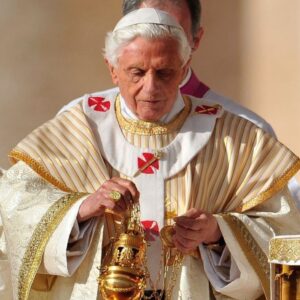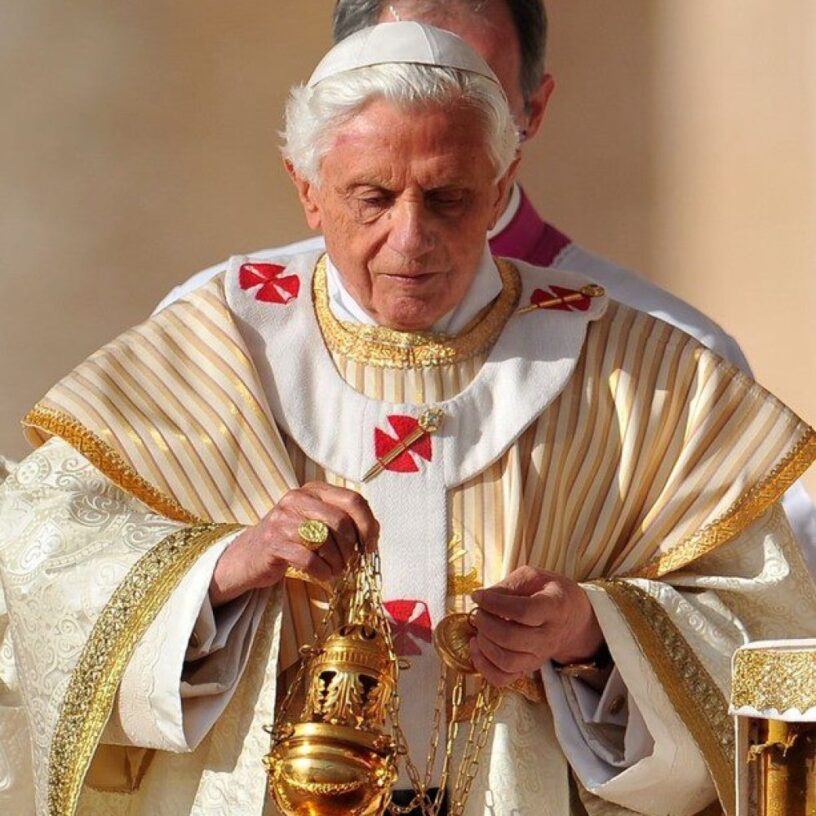
This was originally written as an indignant Amazon review and it is not my usual custom to post negative reviews to my website, but once my furious typing reached 1700 words, I thought I’d better save it for posterity.
I am a solemnly professed Benedict XVI nerd, and I bought Gerry O’Connor’s Subdued Fires: An Intimate Portrait of Pope Benedict XVI on Kindle in one of those 99p flash sales. I have read most of the notable biographies of Pope Benedict XVI, but am always interested in reading critical biographies because they often contain information that more admiring biographers politely leave out. I can therefore speak from my own knowledge of what has been written elsewhere that this biography is not only biased and shockingly badly written, it simply does not even attempt to understand Pope Benedict as a person and it for that reason I would advise anyone to steer clear of this book.
I have never come across Gerry O’Connor before although reading this book and looking through the list of his other works it would appear that he is a popular celebrity biographer who turned to the field after his actual career as a serious playwright and theatre critic wasn’t paying the bills. You know, someone who doesn’t do any actual research or talk to anyone involved but skims through interviews, puff pieces and any other biographies and does a quick, short write-up in a few weeks or months. This book certainly reads like my celebrity unauthorised biographies of Graham Norton and Leonardo DiCaprio.
A celebrity unauthorised biography would simply make an amusing lens to apply to a Pope and theologian who will almost certainly be declared a Doctor of the Church, if not for the absurd tangents O’Connor insists on taking that suit his predetermined narrative and then concluding “did Pope Benedict agree with this? Who’s knows, I’m just asking questions”. The worst way in which this manifests is O’Connor has gotten his hands on the biography of German poet Gunter Grass, a contemporary of Pope Benedict, and simply quotes large passages from his descriptions of living under the Nazi regime and concludes each copy-paste with comments to the effect of, “and Pope Benedict probably thought that too”. It’s extraordinary that for a man who died aged 94 and left behind such a extensive record of his activities that you can enrol in a master’s degree in his thought, that O’Connor felt it necessary to pad out his pages with so many digressions. It feels like he had a keyboard in one hand and Wikipedia in the other.
More concerningly, however, for some reason O’Connor is convinced that Pope Benedict was a Nazi sympathiser and does everything possible to imply, associate and implicate him in ideas that are just impossible to credit if you have actually read any of Benedict’s work. To be sure, Pope Benedict expressed a very rose-tinted view of his early life and other serious biographers have made excellent criticisms of Pope Benedict’s oft-asserted belief that the Catholic Church was the main opposition to the the Third Reich when in fact the communists were much more active and prepared to publicly organise against the Nazis than anyone in Ratzinger’s circle or the German Church. O’Connor makes much of the fact that Pope Benedict’s family repeatedly moved to avoid Nazi oppression and is critical that they didn’t do more to oppose the regime. It’s not an invalid criticism, but personally I find it decidedly very easy to say that ordinary people living in Nazi Germany should’ve done more to fight fascism from one’s armchair located in a world where the fascists don’t have concentration camps and aren’t shooting their opponents in the streets. Opposition meant certain death and martyrdom is not for everyone.
It is very obvious that O’Connor’s main, perhaps sole, source of biographical material is John L. Allen Jr’s Pope Benedict XVI, which was published in 2005. The eight year period between Pope Benedict’s election in 2004 and his resignation in 2013 has been covered through Google search. I am not being facetious about this – Gerry O’Connor states on pg171 that Pope Benedict had a helicopter pilot’s licence and would flew himself to Castel Gandolfo for summer vacations, a statement which is absolutely insane if you think about it for more than five seconds, and it is not true. The reason Gerry O’Connor writes this is because a defunct Catholic website in English mistranslated an Italian newspaper profile of Monsignor Georg Ganswein, Pope Benedict’s personal secretary, who *does* have a pilot’s licence, and promulgated a myth that was repeated all over the internet as a fun fact about the Pope. I know this because when I saw the claim that this elderly man fitted with a pacemaker liked to fly helicopters on the regular, I spent several hours of my life verifying that Pope Benedict, in fact, never learned to drive, never mind flying. Gerry O’Connor saw this absurd claim and just copy-pasted.
This heavy reliance on John L Allen Jr’s 2005 work results in a lopsided narrative where over 50% of the book is dedicated to Pope Benedict’s early life up to his end of his formal education, and perhaps 10% covers the twenty year period in which he became a world-renowned theologian. Pope Benedict’s first published book, Introduction to Christianity, was on the required reading list of every catholic university theology course in the world by the time he was even called to Rome – O’Connor mentions this in passing to explain why Ratzinger was able to afford to build his own house. The remainder of the book is a series of short chapters dedicated to the beats of Pope Benedict’s papacy as measured by the number of news articles dedicated to any given event. We get an entire chapter on Pope Benedict’s state visit to the UK in 2010, for example, even though this was one of 20 pastoral trips that Benedict made during his papacy and nothing much important happened during it. But there’s tons of coverage in English on Google, so… Similarly, the paedophile crisis and Pope Benedict’s handling of it is described entirely from the headlines that O’Connor came across and the actual, unsexy, work Pope Benedict did to reform canon law and shape the Curia’s response is tedious reading for which you will have to turn to actual journalist John L. Allen Jr.
Between this hodgepodge of pilfered anecdotes, cribbed headlines, and “well, I’ve researched it so it’s going in” rambling, O’Connor makes statements about Joseph Ratzinger’s motivations that are simply preposterous. At several points, he infers that Pope Benedict’s shy, quiet outward demeanour was a calculated persona to hide his ambition and lust for power. The reality is that Joseph Ratzinger was not a complicated man – he was an academic who lived in his head and loved info-dumping on what he read in his books, he was conflict averse in his personal and professional relationships, and he was simply resentful of the world changing from the church-centred small community he had grown up in and loved in 1930s Bavaria. All of his actions as Prefect of the CDF and subsequently as Pope which have been so heavily criticised are explained by this perspective, what he himself described as not burdening those of “simple faith”. Pope Benedict lived with his sister all of her life (she died twenty years before him), and he repeatedly invoked her simple Catholic belief, unbothered by high falutin’ theological niceties that so excited him, as his case study of a faith he wanted to protect. For him, the Catholic Church represented authority, order, and stability, and he didn’t have time for anyone or anything that might undermine the cloister. It was for that reason that his academic curiosity that lit up Vatican II was so sharply curtailed by the 1968 student riots. It was for that reason, finding himself in a position for which Pope John Paul II summoned him to Rome against his will (bear in mind that, if you support the ambition argument, in 1981, Pope Benedict was 54, an archbishop and cardinal in addition to his existing global reputation as a theological rockstar and he had no need to go to Rome to further his career), he campaigned against liberation theology, silenced Father Curran and revoked Matthew Fox’s licence to teach. Many of his public condemnations of the threats to faith and family specifically warn against the consequences of “confusion”. You may disagree with this but there is no mystery here. Besides his role enforcing the teaching of the church, Benedict’s comments on Islam, European identity, and homosexuality are simply views that were commonly believed and expressed by any socially conservative seventy year old man in the early 2000s. You may disagree with his views but I find the criticism that the Pope should’ve been more liberal to be the anachronistic view, not the other way round. Just look around you in 2025.
O’Connor’s random diatribes and extended musings on subjects as varied as the history of music in Salzburg, the writings of Dorothy L. Sayers, and just an incredibly long-winded examination of Pius XII’s relationship with the Jews that seemed like it was originally intended to be the context for a critique on his petrine successor’s relationship with the Jews but which never manifested, are all very interesting but it’s hard to trust the credibility of any of this information given the general hack approach of the book. There are also some very strange bedfellows in the Bibliography – O’Connor includes Rabbi Lord Jonathan Sacks’ Dignity of Difference, a book which does not mention Pope Benedict and is itself not mentioned anywhere in the rest of the text. I speculate its inclusion is actually due to a famous photo of Rabbi Sacks meeting Pope Benedict during his state visit to Britain in 2010, a photo which you would be certain to see if you googled “Pope Benedict XVI state visit to Britain”.
In short, this book is trash. I have laboured this review because by every metric, this book is a disgrace – to Joseph Ratzinger’s memory, to writing as a profession, and to Gerry O’Connor’s own dignity. If you are looking for a definitive hagiography of Pope Benedict XVI, you will need to turn to Peter Seewald’s Pope Benedict XVI: A Life Vols. I and II. For the definitive critical biography, we shall have to hope that John Cornwall with squeezes something out before he passes, because there’s nothing to see here.
